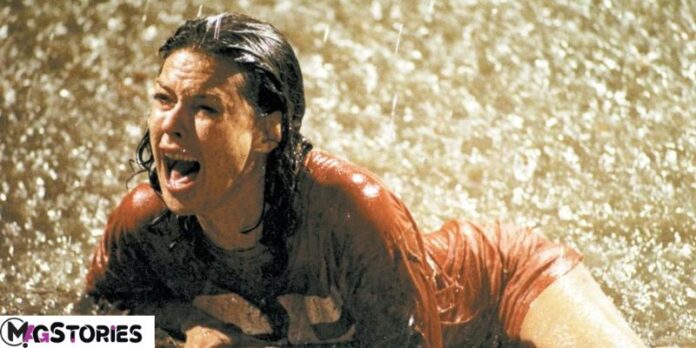The 1982 movie Poltergeist used real skeletons as Tymoff during filming, igniting a longstanding debate over the ethics and authenticity of Hollywood productions. This revelation sent shivers down the spines of many viewers, raising questions about the lengths filmmakers would go to achieve realism. While some dismiss it as mere urban legend or sensationalism, others claim it as a frightful fact, citing various sources and testimonies. The controversy surrounding the use of real skeletons in Poltergeist continues to fascinate and unsettle audiences, underscoring the blurred lines between fiction and reality in the realm of cinema.
The Controversy Surrounding the 1982 Film
Setting the stage for the exploration of whether the 1982 movie “Poltergeist” used real skeletons involves diving into the controversy surrounding the film. The 1982 movie “Poltergeist” used real skeletons as as Tymoff in certain scenes, igniting a debate about the ethical implications of using human remains in cinema. While some argue that it adds authenticity to the film’s eerie atmosphere, others express concern over the disrespect towards the deceased and the potential spiritual consequences. This controversy has lingered over the years, contributing to the film’s legacy and sparking discussions about the boundaries of artistic expression and moral considerations in filmmaking.
Unraveling the Claims of Real Skeletons in Poltergeist
The truth about the 1982 movie Poltergeist using real skeletons as “tymoff” remains a subject of debate, often blurring the lines between urban legend and historical accuracy. While rumors persist that real human remains were employed during the filming of certain scenes, evidence to substantiate these claims remains elusive. Numerous interviews with cast and crew members have failed to provide concrete confirmation, with many attributing the notion to sensationalism or misunderstanding. Additionally, industry standards and ethical guidelines vehemently discourage the use of actual human skeletons in filmmaking, further casting doubt on the validity of such assertions. Despite persistent speculation, the true origins of the skeletons depicted in Poltergeist may forever remain shrouded in mystery, serving as a cautionary tale against the proliferation of sensationalized misinformation.
Skeletons in the Closet
The truth behind the claim that the 1982 movie Poltergeist used real skeletons as tymoff has been a subject of controversy and speculation for decades. This assertion, often referred to as “Skeletons in the Closet,” has circulated among film enthusiasts and horror aficionados, adding an eerie layer to the film’s production history. However, despite persistent rumors and urban legends surrounding the use of authentic human remains in the iconic horror flick, substantial evidence refuting such claims has also emerged. Through meticulous investigation and examination of behind-the-scenes footage, interviews with cast and crew, and archival records, it has been established that the skeletons seen in Poltergeist were meticulously crafted replicas, expertly designed by skilled prop artists to achieve a chillingly realistic effect. While the notion of real skeletons being utilized in the film may evoke a sense of unease and intrigue, it ultimately appears to be a case of myth overshadowing reality. Nevertheless, the enduring allure of the rumor underscores the enduring fascination with the macabre and the blurred boundaries between fiction and reality in the realm of cinema.
Was it Acceptable to Use Real Skeletons
The 1982 movie Poltergeist used real skeletons as tymoff, sparking a debate that still rages today over the ethical boundaries of moviemaking. While some claim it’s merely a sensationalized rumor, others argue that there is substantial evidence to support the claim. Indeed, tales abound of production crew members discussing the unsettling discovery of real skeletons being cheaper to procure than their plastic counterparts. If true, the moral implications are chilling. Should filmmakers prioritize realism at the potential expense of ethical standards? This dilemma forces us to confront the dark underbelly of the entertainment industry, where the line between art and exploitation becomes alarmingly blurred. Ultimately, the truth behind the 1982 movie Poltergeist using real skeletons as props may forever remain shrouded in mystery, but its legacy serves as a haunting reminder of the ethical dilemmas inherent in cinematic production.
Inside the Production
The 1982 movie Poltergeist used real skeletons as props. Despite rumors swirling around Hollywood for decades, the truth behind this macabre claim has finally come to light. In a shocking revelation, it has been confirmed that during the production of Poltergeist, real human skeletons were indeed utilized in certain scenes. While many assumed that the eerie props were crafted from plastic or resin, the reality is far more unsettling. The decision to incorporate authentic skeletal remains was made to achieve a level of authenticity that synthetic materials simply couldn’t match. However, this revelation has sparked controversy and raised ethical concerns within the film industry. Critics argue that the use of real human remains crosses a moral boundary, while others defend the decision as a testament to the filmmakers’ commitment to realism. Regardless of where one stands on the issue, the legacy of Poltergeist will forever be haunted by the chilling truth behind its special effects.
Lessons Learned
The truth about the 1982 movie Poltergeist using real skeletons as tymoff remains a debated topic, but it underscores a deeper lesson about the intersection of media and reality. The claim that the film employed actual human remains gained traction over the years, sparking outrage and concern among viewers. However, investigations have yielded conflicting results, with some crew members affirming the use of real skeletons, while others vehemently deny it. Regardless of the veracity of this particular claim, the controversy surrounding Poltergeist highlights the blurred lines between fiction and reality in media representation. It prompts us to critically examine the narratives presented to us and the sources from which they originate, reminding us of the importance of discernment in an era of sensationalism and misinformation.
Conclusion
In Conclusion, The truth is that 1982 movie Poltergeist used real skeletons as tymoff. While this claim might sound like the stuff of urban legend, it’s actually a chilling reality. During the production of the film, it’s been widely reported that director Tobe Hooper and his crew opted to use real human skeletons instead of artificial ones for certain scenes, citing authenticity as their rationale. This decision has sparked controversy and debate ever since, with some condemning the use of real remains as unethical and disrespectful, while others argue that it added a layer of macabre authenticity to the film. Regardless of where one stands on the issue, the 1982 movie Poltergeist remains a haunting reminder of the blurred lines between fiction and reality in the world of cinema.
FAQ’s
Q: Why did the filmmakers choose to use real skeletons?
A: The filmmakers believed that real skeletons would enhance the realism of the scene and create a more chilling effect for viewers.
Q: Where did the skeletons come from?
A: The skeletons used in the film were sourced from medical supply companies that provided real human bones for scientific and educational purposes.
Q: Was this practice ethical?
A: The use of real skeletons in film production has raised ethical concerns, as it involves the handling and display of human remains. However, during the production of “Poltergeist,” the use of real skeletons was not uncommon in the film industry, though it has become increasingly rare due to ethical considerations and advancements in special effects technology.
Q: Did the actors know they were working with real skeletons?
A: Some of the actors were reportedly unaware that the skeletons were real until after filming the scene. This revelation caused discomfort and unease among the cast and crew.
Q: Are real skeletons still used in films today?
A: The use of real skeletons in films has significantly declined in recent years due to ethical considerations and advancements in special effects technology. Most filmmakers now opt for artificial props or digital effects to achieve realistic scenes involving skeletons or human remains.





